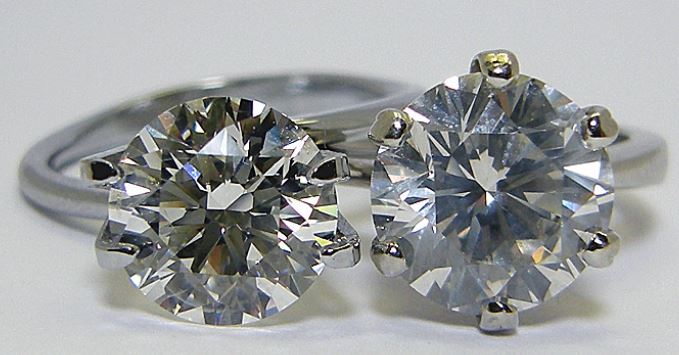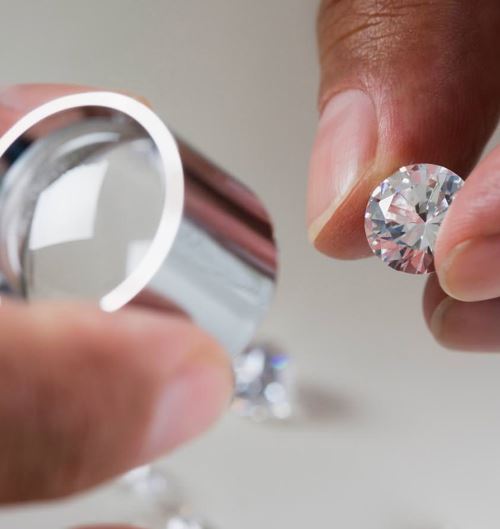A Basic Diamond Clarity Guide for Everyone to Understand
Purchasing diamonds requires some preliminary research. Besides, you have to know what to look for, as you won’t be able to exceed your given budget by far. This is why you need to learn about the 4Cs, the four characteristics that influence the beauty and therefore the price of these gemstones. There are some you can compromise on, in order to get a lower price, but there are others that can spoil a diamond if you go too low on them.
 The diamond clarity is one of the most versatile features. It refers to the number of flaws a stone has. As diamonds are born deep inside the earth, under extreme temperature and pressure conditions, the aren’t always pure. Tiny foreign particles may get caught inside the crystal, forming the so-called inclusions. When these flaws occur at the surface of the gem, they are known as blemishes. The size and the number of inclusions and blemishes determines the clarity grade of a diamond.
The diamond clarity is one of the most versatile features. It refers to the number of flaws a stone has. As diamonds are born deep inside the earth, under extreme temperature and pressure conditions, the aren’t always pure. Tiny foreign particles may get caught inside the crystal, forming the so-called inclusions. When these flaws occur at the surface of the gem, they are known as blemishes. The size and the number of inclusions and blemishes determines the clarity grade of a diamond.
This characteristic is measured on a specific scale with multiple items. Flawless diamonds are on top of the scale, their purity being perfect. As you can imagine, their price is also on top of the scale. As a matter of fact, such stones are very rare, so most buyers don’t even have a chance to encounter one.
The good news is that you can be very happy with lower clarity grades. Near Flawless and Internally Flawless diamonds appear pure to the naked eye. The grading is always done by experts, under 10x magnification. In case of NF and IF stones, only experts can notice their blemishes, provided that they do their examination under 10x magnification. One of the most solid websites on the internet that provides knowledge on the clarity of diamonds is yourdiamondteacher.com. When it comes to the diamond clarity you have to use the opportunity to save yourself some money. We will show you how.
But first, let us talk a more precise look at the different clarity grades!
The different Clarity Ranges and What they mean
The Very, Very Slightly Included range consists from two grades, VVS1 and VVS2. These stones have inclusions, but they are so small that even an expert grader would have difficulties in seeing them with the naked eye. These imperfections are visible only under 10x magnification and they are really minor. These diamonds appear perfect to the untrained eye. Their price is also quite high, so you may not want to choose one of them for an engagement ring, unless your beloved one is a jeweler or an expert grader.
 VS1 and VS2 are the Very Slightly Included stones. They can provide an excellent value for money, as their inclusions are very difficult to spot. Some untrained observers may be able to spot the inclusions of a VS2, but only under ideal conditions. These grades can be an excellent bet, should you be looking to buy diamonds as an investment. Their value has been constant over time, and with scarcity kicking in, it can only go up.
VS1 and VS2 are the Very Slightly Included stones. They can provide an excellent value for money, as their inclusions are very difficult to spot. Some untrained observers may be able to spot the inclusions of a VS2, but only under ideal conditions. These grades can be an excellent bet, should you be looking to buy diamonds as an investment. Their value has been constant over time, and with scarcity kicking in, it can only go up.
The Slightly Included diamonds, SI1 and SI2, have flaws that can be easily observed by expert graders. Even untrained observers may be able to see the flaws on SI2 stones, as they are quite large. This is why SI1 is the grade you should be looking for when shopping for diamonds. The beauty of a stone is influenced by the position of these inclusions. If they are located immediately under the girdle, they may not interfere with the path of light through the stone. In such cases, diamonds appear perfect to the naked eye of the untrained individuals. These gems are the perfect choice for an engagement ring, as they are going to look wonderful, while being accessible in terms of prices. However, you have to be prepared to do a lot of research work in order to be able to find such a gem. SI2 can also be good, but again, this depends on the position of the inclusions. If you are lucky, you can find excellent value in this clarity grade, as well.
The last on the GIA clarity scale are the Included diamonds. Their flaws are visible and they reduce the brilliance of the stones. This makes them less sought after. As a matter of fact, major diamonds companies don’t even offer them to their clients. One of the reasons is that these large inclusions may affect the durability of the gems. A fragile diamond isn’t something to wish for.
It is up to you
In conclusion, it’s clear that shopping for diamonds is a long-term process. If you want to find the best gems, you need to be patient and to search and compare various stones until you find the perfect compromise that enables you stick to your budget, without forcing you to accept an ugly stone. You should strive to find a VS1 or a VS2, as they are going to look great. Nonetheless, there are chances to find great value in SI1 diamonds, provided that their inclusions are positioned in a way that makes them invisible when the diamond in examined from the top. This is how to choose your diamond in terms of clarity.

The chart above gives you the idea of what you can expect each clarity grade to be like in general. We like to stress the importance of the word “in general” however!
If you just want to follow the general guidelines you will be good to go with a VS2 diamond. But if you really go into it and make the effort to understand the issue you will know that it is very well worth looking into SI1 and for that matter even into SI2 diamonds! In fact, this is what we strongly recommend you do if you are serious about saving money!
Applied Knowledge
John from Houston for instance that took advantage of our diamond consultation service. He originally wanted to buy a IF diamond in the diamond district in New York. He was told by the staff of well known company that an IF diamond would make the diamond sparkle even more! Unfortunately, this is absolutely untrue and misleading!
The clarity grade itself will have nothing to do with the sparkle of a diamond. An exception would only exist if the clarity grade is so low that the inclusions can be seen with the bare eyes. This of course is something that we really want to avoid.
But other than that the clarity grade of a diamond does not have any impact whatsoever on the brilliance of a diamond. Just be careful that you really get this into the head.
The end of the story is that we actually found John a wonderful SI1 diamond that looked even better than the diamond that he wanted to buy. The great thing though was that John was even able to save himself nearly 25% off the original purchase price. Contact us if you want to get our advice how to save money like that!
